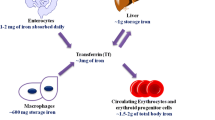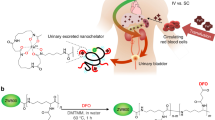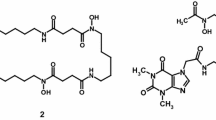Abstract
Deferasirox (DFX), an orally active and clinically approved iron chelator, is being used extensively for the treatment of iron overload. However, its water insolubility makes it cumbersome for practical use. In addition to this, the low efficacy of DFX to remove brain iron prompted us to synthesize and evaluate a DFX-TAT(47–57) peptide conjugate for its iron chelation properties and permeability across RBE4 cell line, an in vitro model of the blood–brain barrier. The water-soluble conjugate was able to remove labile iron from buffered solution as well as from iron overloaded sera, and the permeability of DFX-TAT(47–57) conjugate into RBE4 cells was not affected compared to parent deferasirox. The iron bound conjugate was also able to translocate through the cell membrane.




Similar content being viewed by others
References
Andersen JK (2004) Oxidative stress in neurodegeneration: cause or consequence? Nat Rev Neurosci 5(Suppl):S18–S25
Batista-Nascimento L, Pimentel C, Menezes RA, Rodrigues-Pousada C (2012) Iron and neurodegeneration: from cellular homeostasis to disease. Oxid Med Cell Longev. doi:10.1155/2012/128647
Brooks H, Lebleu B, Vives E (2005) Tat peptide-mediated cellular delivery: back to basics. Adv Drug Deliv Rev 57(4):559–577
Bruin GJM, Faller T, Wiegand H, Schweitzer A, Nick H, Schneider J, Boernsen K-O, Waldmeier F (2008) Pharmacokinetics, distribution, metabolism, and excretion of Deferasirox and its iron complex in rats. Drug Metab Dispos 36(12):2523–2538
Choudhury VP, Naithani R (2007) Current status of iron overload and chelation with deferasirox. Indian J Pediatr 74(8):759–764
Druglead (2015) http://www.druglead.com/cds/deferasirox.html. Accessed 12th June 2015
Espósito BP, Breuer W, Sirankapracha P, Pootrakul P, Hershko C, Cabantchik ZI (2003) Labile plasma iron in iron overload: redox activity and susceptibility to chelation. Blood 102(7):2670–2677
Espósito BP, Epsztejn S, Breuer W, Cabantchik ZI (2002) A review of fluorescence methods for assessing labile iron in cells and biological fluids. Anal Biochem 304(1):1–18
Finkenstedt A, Wolf E, Höfner E, Gasser BI, Bösch S, Bakry R, Creus M, Kremser C, Schocke M, Theurl M, Moser P, Schranz M, Bonn G, Poewe W, Vogel W, Janecke AR, Zoller H (2010) Hepatic but not brain iron is rapidly chelated by deferasirox in aceruloplasminemia due to a novel gene mutation. J Hepatol 53(6):1101–1107
Food and Drug Administration (2015) Waiver of in vivo bioavailability and bioequivalence studies for immediate-release solid oral dosage forms based on a biopharmaceutics classification system: guidance for industry. Food and Drug Administation Rockville, MD. http://www.fda.gov/downloads/drugs/guidancecomplianceregulatoryinformation/guidances/ucm070246.pdf. Accessed 12th June 2015
Gabathuler R (2010) Approaches to transport therapeutic drugs across the blood-brain barrier to treat brain diseases. Neurobiol Dis 37(1):48–57
Goswami D, Machini MT, Silvestre DM, Nomura CS, Espósito BP (2014) Cell penetrating peptide (CPP)-conjugated Desferrioxamine for enhanced neuroprotection: synthesis and in vitro evaluation. Bioconjugate Chem 25(11):2067–2080
Kamalinia G, Khodagholi F, Atyabi F, Amini M, Shaerzadeh F, Sharifzadeh M, Dinarvand R (2013) Enhanced brain delivery of Deferasirox-Lactoferrin conjugates for iron chelation therapy in neurodegenerative disorders: in vitro and in vivo studies. Mol Pharm 10(12):4418–4431
Kurrikoff K, Suhorut J, Langel Ü (2011) Chapter 37: cell-penetrating peptides in cancer targeting. In: Kratz F, Senter P, Steinhagen H (eds) Drug delivery in oncology: from basic research to cancer therapy. Wiley-VCH Verlag GmbH & Co. KGaA, Weinheim, pp 1187–1217
Langel Ü (2002) Cell-penetrating peptides: processes and applications. CRC Press, Boca Raton, p 257
Lee S-M, Yoon M-Y, Park H-R (2008) Protective effects of Paeonia lactiflora pall on hydrogen peroxide-induced apoptosis in PC12 cells. Biosci Biotechnol Biochem 72(5):1272–1277
Mazel M, Clair P, Rousselle C, Vidal P, Scherrmann J-M, Mathieu D, Temsamani J (2001) Doxorubicin-peptide conjugates overcome multidrug resistance. Anti-cancer Drug 12(2):107–116
Mishra A, Lai GH, Schmidt NW, Sun VZ, Rodriguez AR, Tong R, Tang L, Cheng J, Deming TJ, Kamei DT, Wong GCL (2011) Translocation of HIV TAT peptide and analogues induced by multiplexed membrane and cytoskeletal interactions. Proc Natl Acad Sci USA 108(41):16883–16888
Mounsey RB, Teismann P (2012) Chelators in the treatment of iron accumulation in Parkinson's disease. Int J Cell Biol. doi:10.1155/2012/983245
Novartis (2015) https://www.pharma.us.novartis.com/product/pi/pdf/exjade.pdf. Accessed 12th June 2015
Reichel A, Abbot NJ, Begley DJ (2002) Evaluation of the RBE4 cell line to explore carrier-mediated drug delivery to the CNS via the L-system amino acid transporter at the blood-brain barrier. J Drug Target 10(4):277–283
Rousselle C, Clair P, Lefauconnier JM, Kaczorek M, Scherrmann JM, Temsamani J (2000) New advances in the transport of Doxorubicin through the blood-brain barrier by a peptide vector-mediated strategy. J Mol Pharmacol 57(4):679–686
Sripetchwandee J, Pipatpiboon N, Chattipakorn N, Chattipakorn S (2014) Combined therapy of iron chelator and antioxidant completely restores brain dysfunction induced by iron toxicity. PLoS ONE 9(1):e85115
Schwarze SR, Ho A, Vocero-Akbani A, Dowdy SF (1999) In vivo protein transduction: delivery of a biologically active protein into the mouse. Science 285(5433):1569–1572
Tai M, Matsuhashi N, Ichii O, Suzuki T, Ejiri Y, Kono S, Terada T, Miyajima H, Harada M (2014) Case of presymptomatic aceruloplasminemia treated with deferasirox. Hepatol Res 44(12):1253–1258
Wilhelm I, Fazakas C, Krizbai IA (2011) In vitro models of the blood-brain barrier. Acta Neurobiol Exp 71(1):113–128, and the references cited therein
Yang LP, Keam SJ, Keating GM (2007) Deferasirox: a review of its use in the management of transfusional chronic iron overload. Drugs 67(15):2211–2230
Acknowledgments
DG received a postdoctoral fellowship from São Paulo Research Foundation (FAPESP 11/18958-0). FAPESP and CNPq funded these investigations. The authors thank Dr. Cleber Wanderlei Liria for discussions and technical assistance.
Author information
Authors and Affiliations
Corresponding author
Rights and permissions
About this article
Cite this article
Goswami, D., Vitorino, H.A., Alta, R.Y.P. et al. Deferasirox-TAT(47–57) peptide conjugate as a water soluble, bifunctional iron chelator with potential use in neuromedicine. Biometals 28, 869–877 (2015). https://doi.org/10.1007/s10534-015-9873-5
Received:
Accepted:
Published:
Issue Date:
DOI: https://doi.org/10.1007/s10534-015-9873-5




